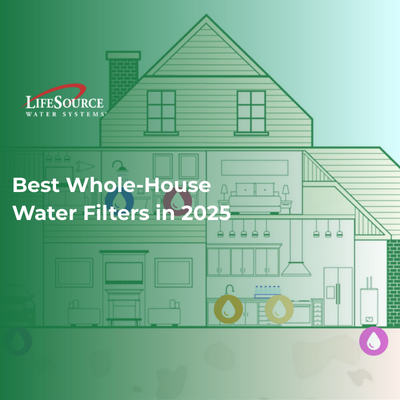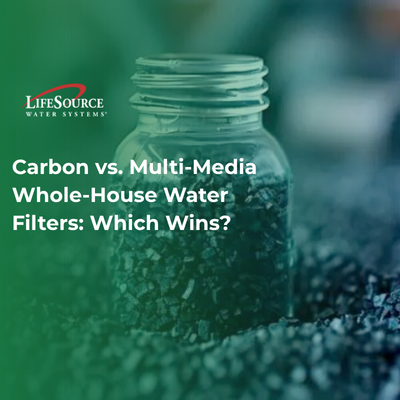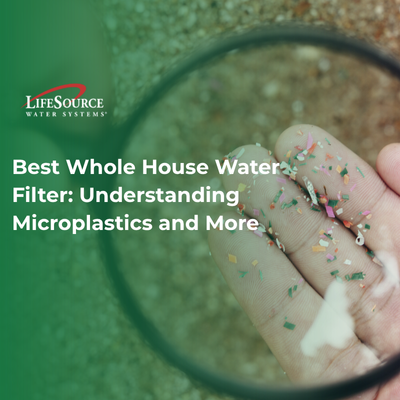
Do You Know What's In Your Water?
Microplastics are so small they can’t be seen, yet these particles are an increasingly big problem. These tiny pieces of plastic, less than 5 millimeters in size, can cause inflammation, spur or worsen autoimmune disorders, and negatively impact the liver and lungs. A shocking 2024 report from the New England Journal of Medicine even found that microplastics in an artery make heart attacks and strokes 4.5 times as likely.
With the rise of plastic in many consumer goods, including synthetic clothing, the problem is becoming more clear. The World Economic Forum labeled it a “new health crisis,” citing that we eat, drink, and breathe thousands of microplastics each year.
This knowledge can be scary and overwhelming – but there are ways to protect your home and take control of your health. Learn why a whole-house water filtration system is crucial, plus how to get started.
Microplastics introduce harmful chemicals and metals into our bodies. Researchers have discovered them in human blood, lungs, brains, and hearts, and have started to note some common effects:
Heart disease. Strokes and heart attacks become more likely when microplastics enter the human body.
Respiratory disorders. Scientists link microplastics to increased rates of lung cancer and asthma.
Neurological symptoms. Microplastics impact brain tissue, making us dizzy and more easily tired. They can also increase the risk of Parkinson’s, according to the National Institutes of Health.
Metabolism interference. Once microplastics are in our bodies, they disrupt our energy levels and ability to break down fatty acids.
Reproductive consequences. Microplastics affect sex hormones, the endocrine system, and overall fertility, especially male fertility.
One of the most common ways microplastics enter the human body is through water. Bathing, doing laundry, and staying hydrated are all daily tasks that can pose an unexpected danger.
Sometimes, larger plastic items break down into smaller pieces, resulting in microplastics. Plus, many other elements of your daily routine increase the risk of coming into contact with microplastics:
Washing clothes. Synthetic clothing releases millions of plastic microfibers in the wash.
Road run-off from vehicles. Car paint and tire rubber can wear off slowly over time and enter the waterway.
Plastic bottles, straws, and utensils. Disposable cutlery might be convenient, but it isn’t the safest. Drinking from a plastic water bottle, with a plastic straw, or using plastic forks, knives, and spoons can make encountering microplastics more likely.
While some microplastic risk factors can be reduced through our behavior, others are out of our control. For instance, it’s likely some microplastics enter the water supply every time it rains. This means it’s best to be prepared: Know that microplastics are common, but that detecting and filtering them out greatly reduces their impact.

Microplastics can’t be seen, smelled, or tasted. That means testing for them is critical. You can get a lab to test your water, use a specialized sensor, or invest in a water test or kit.
One method is LifeSource’s Advanced Professional Water Test, which gives you everything you need to test your well water and send it to a professional lab (including pre-paid shipping). Once the lab finishes testing your water sample, you receive a detailed report and analysis of recommended next steps.
There are a few simple changes you can make to greatly reduce your exposure to microplastics.
Avoid synthetic fabrics, or wash them less frequently. When possible, opt for fabrics like organic cotton, wool, and linen. If you do have synthetic fabrics in your wardrobe, there are still ways to stay safe – wash clothes on cold, choose to air dry items when you can, and do larger loads of laundry so there’s less friction.
Reduce single-use plastic. One of the best ways to cut down on the microplastics we encounter is by limiting the amount of larger plastic in our lives. Try to stay away from plastic packaging, plastic water bottles and utensils, and use ceramic or glass containers to store food instead. Think about where you can reuse items in your day-to-day routine.
Filter your water. Of all the things we eat and drink, water is the most common and vital. Don’t let it become a source of microplastics – instead, rely on water filters, which reduce contaminants and harmful particles.

Water filtration systems trap and remove even very small particles from your water, greatly reducing the threat of microplastics. A whole-house filtration system, like the one offered by LifeSource, protects your entire home – from the water you drink, to the water in your washing machine and shower.
LifeSource Water Systems use activated carbon filters to ensure safe water from every faucet in your home. Plus, we know you don’t want to worry about microplastics, but that you also don’t want to worry about regular maintenance. With LifeSource, you don’t have to change tanks, lug salt bags, or replace filters monthly to keep your water supply healthy and secure.








